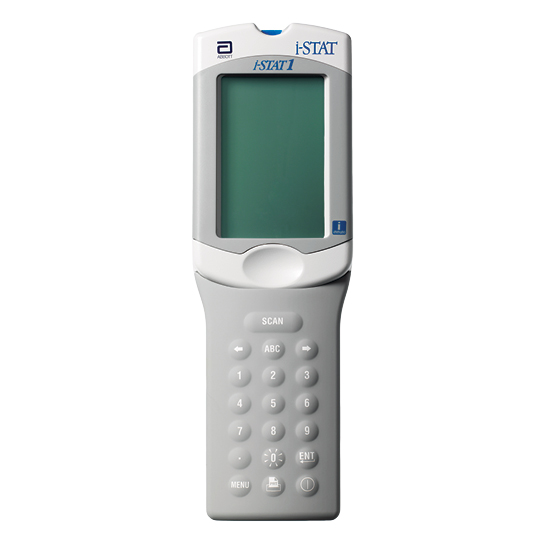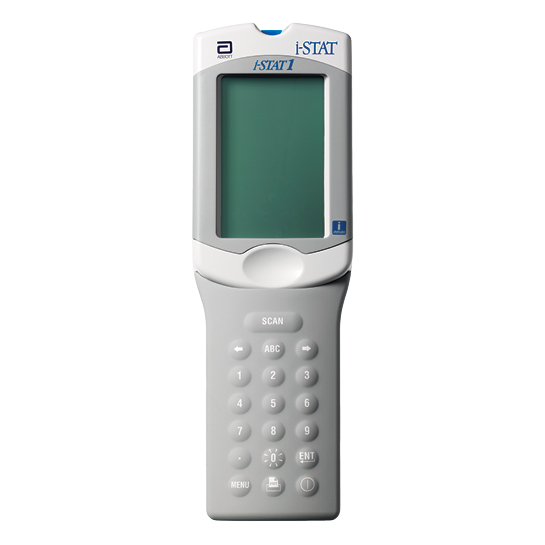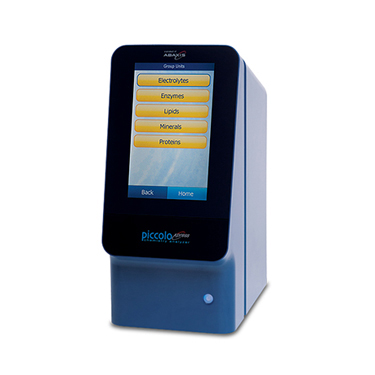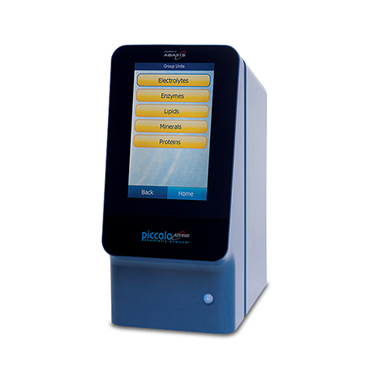Global Point of Care
make an impact in your facility
The i-STAT 1, i-STAT Alinity and Piccolo Xpress systems help deliver collaborative, patient-centered care and can drive performance in a variety of healthcare settings. In minutes, these products can deliver lab-quality results and accurate record-keeping. This allows healthcare professionals to quickly respond to any need and condition where and when care is needed.
select a setting below to learn more



General Acute Care Hospitals
A healthcare institution providing medical treatment to patients with specialized medical and nursing staff and equipment, usually on an in-patient basis



Outpatient: Settings for diagnosing and treating illnesses and injuries on an outpatient basis.
Long-term Care: Skilled nursing settings, nursing homes, Long -term chronic and Long-term acute care hospitals, Post-Acute Care settings.

Hospital Settings
Hospital Settings



THE i-STAT System can play a valuable role throughout the hospital in:
- INCREASING SYSTEM EFFICIENCY
- supporting quality and compliance initiatives
- ACCELERATING THE DECISION-MAKING PROCESS
- improving metrics & lowering the total cost of care
The i-STAT System allows for critical testing at the patient’s side, providing fast, reliable, diagnostic, treatment, and prognostic indicators offering the potential for even the smallest hospital to improve both system efficiency and patient care.
select a tab above to explore a hospital setting
CRITICAL CARE
Critical care departments include a wide range of specialty areas that administer care to many of the hospital’s most critically ill patients. With ICU costs constituting a large portion of total hospital costs, (accounting for 8%–30% of total hospital budget)1, and a patient bed in an ICU costing the hospital as much as 3 times more than the cost of a bed in the non-icu,2 hospital administrators are challenged daily to help reduce costs. The i-STAT System offers solutions to help achieve these goals.
EMERGENCY DEPARTMENT
ED overcrowding puts stress on caregivers and is a major patient safety concern associated with poor patient outcomes.3 Increased ED volume can mean patients face long periods of waiting4 which can be a key obstacle to timely patient treatment and disposition. Having accurate results sooner can accelerate triage and treatment decisions that can help EDs overcome these challenges.
CVOR/CATH LAB
Because of the delicate nature of surgery, real-time test results are often critical, yet results from the central lab can take 60 minutes5 or more. Costly challenges, such as surgical cancellations, can add up, while the sharing of benchtop blood-gas-analysis systems among operating rooms can cause delays due to the nurse having to leave the room, the system already being in use or frequent calibration requirements. The variables can potentially increase staffing requirements and impact patient care. Analysis via bench-tops (where the operating room assistant must leave the room to perform tests) can be costly, as well as potentially increase staffing requirements and impact patient care.
In the Cath Lab, it’s important that both activated clotting time (ACT) and blood gas results are readily available.
The i-STAT System offers quick results for most tests needed for surgery on a single, portable platform, while providing all tests needed in the Cath Lab with better reproducibility than some benchtop systems.6
LABORATORY
Bedside testing can be a valuable resource that can help improve efficiencies and maintain quality while relieving pressure on the lab. By reducing the number of test requests and call-back procedures, lab staff is freed from routine testing and can focus on more complex, time-consuming tests and high-volume, reference-lab testing. Integrating a POC testing system into lab processes can promote patient-centric care, increase lab efficiency, and help reduce costs
RADIOLOGY
Millions of contrast medium-assisted radiological examinations are conducted each year. However, these procedures are not without risk of adverse events. Renal failure due to the administration of contrast media is reported to be the third most common cause of in-hospital renal failure, after hypotension and surgery.7 Another danger in performing radiological investigations in women of childbearing age is pregnancy status. Assessing pregnancy status can cause delays in processing patients for investigations.8
RESPIRATORY CARE
In the respiratory therapy area, point-of care testing enables rapid analysis of blood gases so respiratory therapists can gain a greater degree of control over a patient's respiratory condition. With many current testing models, the RT must leave the bedside for blood analysis, taking time away from the patient and necessary breathing treatments.
Testing with the i-STAT System allows RTs to more fully integrate with the care team at the patient's bedside.
related topics



ENHANCING PATIENT SAFETY
With regulations related to mandatory overtime and clinical process measures, evidence is mounting regarding the impact of workload on patient outcomes and errors.



free your resources from the high costs of sepsis
By administering two point-of-care lactate tests in the ED (one on arrival and one before ICU admission), your team can reduce both costly ICU admissions and pressure on the lab at a time when staffing is in crisis.



the economic benefits of point-of-care testing
In addition to the obvious benefits to medical staff and patients, economic benefits can result from the adoption of a with-patient testing platform.
let us help your facility meet its goals
outpatient and ltc settings
experience the power and versatility to meet your testing needs in a variety of settings with the
i-STAT® OR PICCOLO®:
- URGENT CARE/FSED
- ONCOLOGY
- AMBULATORY SURGERY
- FAMILY PRACTICE
- INTERNAL MEDICINE
- IMAGING CENTERS
experience the power and versatility to meet your testing needs in a variety of settings with the
i-STAT® OR PICCOLO®:
- URGENT CARE/FSED
- ONCOLOGY
- AMBULATORY SURGERY
- FAMILY PRACTICE
- INTERNAL MEDICINE
- IMAGING CENTERS
The i-STAT System and Piccolo systems allow for diagnostic testing at or near the patient, providing lab accurate test results in minutes9
Having results quickly allows the provider to make informed care decisions during the patient visit, which can improve patient satisfaction2, and reduce costs3
select a tab above to explore community healthcare settings
Urgent CARE/FSED
Urgent Care and Free-Standing Emergency Departments
are key to reducing the burdens on hospital emergency rooms.15,16 Implementing point of care testing in these environments can help centers of all sizes and profiles lower the overall cost of care and optimize resource utilization by improving efficiency.3
Reducing wait times and having the ability to make informed care decisions during the visit can also improve patient satisfaction3,10,13.
ONCOLOGY INFUSION CENTERS
The i-STAT and Piccolo Point of Care systems make testing fast and simple for staff with fully automated systems12 that allow providers to review results and determine patients’ ability to receive treatment on site. These testing platforms provide proven accuracy and precision.1
AMBULATORY SURGERY CENTERS
Point of Care testing in the Ambulatory Surgery Center may help to avoid procedure cancellations and delays due to missing lab results. The i-STAT and Piccolo systems provide proven accuracy and precision9 with pre, intra, and post-op testing.
Physician Office
Point of Care testing is ideal in the primary or specialty physician practice by helping to reduce wait times10, reduce costs and optimize resource utilization11, and by allowing the provider to make informed clinical decisions during the patient visit. Point of Care testing may also lead to a significant reduction in the number of tests ordered11.
This eliminates the need for patient call-backs by staff, adding to the overall efficiencies and resource utilization of a practice. Reducing wait times and having the ability to make informed care decisions during the visit can also improve patient satsifaction10,13.
LONG-TERM CARE
For skilled nursing facilities (SNF), nursing homes, post-acute care (PAC) facilities, and long-term acute and chronic care hospitals, transform patient care with in-facility testing. Reduce the risk of avoidable readmissions and CMS interrupted stay penalties.
REALIZE THE BENEFIT
i‑STAT offers healthcare professionals the tools needed to make diagnostic decisions when and where they are needed
benefit from a broad test menu
The i‑STAT System provides a comprehensive menu of the most commonly performed tests, ideal for meeting the needs of various hospital department settings.
increase system efficiency and productivity
Only a few simple steps are required to get lab-quality test results in less time4 and at lower cost.14 Quickly respond to any need or change in a patient’s condition while at the bedside.
PROMOTE COLLABORATION
Real-time results allow clinical teams the ability to collaborate at the patient's side to make immediate treatment decisions, helping to impact efficiency and throughput.
reduce potential for errors
Quality checks of sample integrity, sensors, and fluidics are automatic with each i‑STAT cartridge, providing confidence and advanced performance to help improve quality of care.



i-STAT can help you achieve your goals



i-STAT can help you achieve your goals
references
- Cost Analysis on Intensive Care Unit Costs Based on the Length of Stay. Turk J Anaesthesiol Reanim. 2019 Apr; 47 (2): 142-145
- Care in Candian ICUs. Canadian Institute for Health Information, August 2016
- Carter EJ et al. J Nurs Scholarsh 2014; 46:106-15.
- Jarvis PRE et al. Br J Hospit Med 2014;75:397-400.
- National Institute for Health and Care Excellence. Detecting, managing and monitoring haemostasis: viscoelastometric point of care testing. August 2014. www.nice.org.uk/guidance/dg13.
- Activated Clotting Time (ACT): Comparison of the Hemochron Signature Elite and the Abbott i-STAT. Authors Lilah M. Evans, Susanne Gallo, Joseph Leo, Barbara M. Goldsmith. https: //jdc.jefferson.edu/cgi/viewcontent.cgi?article=1004&context=pacbposters
- Briguori, C., Tavano, D., Colombo, A., “Contrast Agent-Associated Nephrotoxicity.” Progress in Cardiovascular Diseases, 2003.45(6): 493-503. https://moh-it.pure.elsevier.com/en/publications/contrast-agent-associated-nephrotoxicity
- National Institute for Health Research. Point-of-care-testing-for-human-chorionic-gonadotophin hcg. www.community.healthcare.mic.nigh.ac.uk
- Data on file Abbott Point of Care Inc., Instructions for use, test comparison tables
- Press Ganey 2009 Medical Practice Pulse Report (Represents the experiences of 2,373,288 patients treated at 10,214 sites nationwide).
- Crocker J, et al, Implementation of Point-of-Care Testing in an Ambulatory Practice of an Academic Medical Center, Am J Clin Pathol, November 2014; 142:640-646.
- Koehler J, Flarity K, Hertner G, et al. Effect of troponin I Point-of-Care testing on emergency department throughput measures and staff satisfaction. Adv Emerg Nurs J. 2013;35(3):270-277. doi:10.1097/TME.0b013e31829d2048.
- What Do Consumers Want from Primary Care? 10 Insights from the Primary Care Consumer Choice Survey, The Advisory Board Company, Marketing and Planning Leadership Council 2014.
- Schilling UM. The economic benefits of point-of-care testing. Hospital Healthcare Europe, special supplement, 2015. www.hospitalhealthcare.com
- National Library of Medicine. Freestanding Emergency Departments Are Associated With Higher Medicare Costs: A Longitudinal Panel Data Analysis. August 2017. https://www.ncbi.nlm.nih.gov/pmc/articles/PMC5798671.
- National Library of Medicine. The impact of urgent care centers on nonemergent emergency department visits. February 2021. https://www.ncbi.nlm.nih.gov/pmc/articles/PMC8313962



















